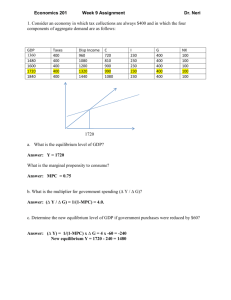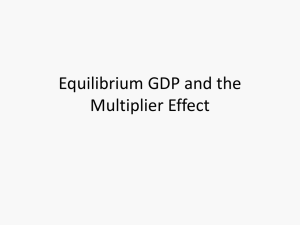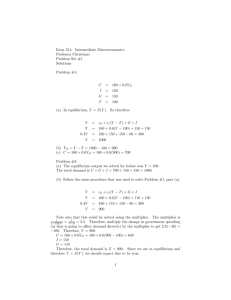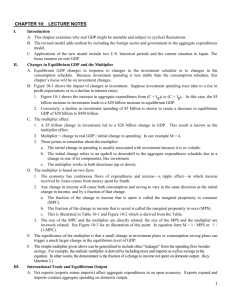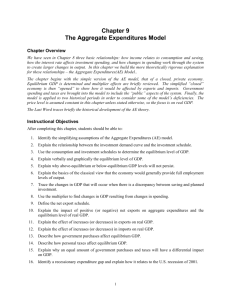Lecture 8: The Aggregate Expenditures Model Reference
advertisement
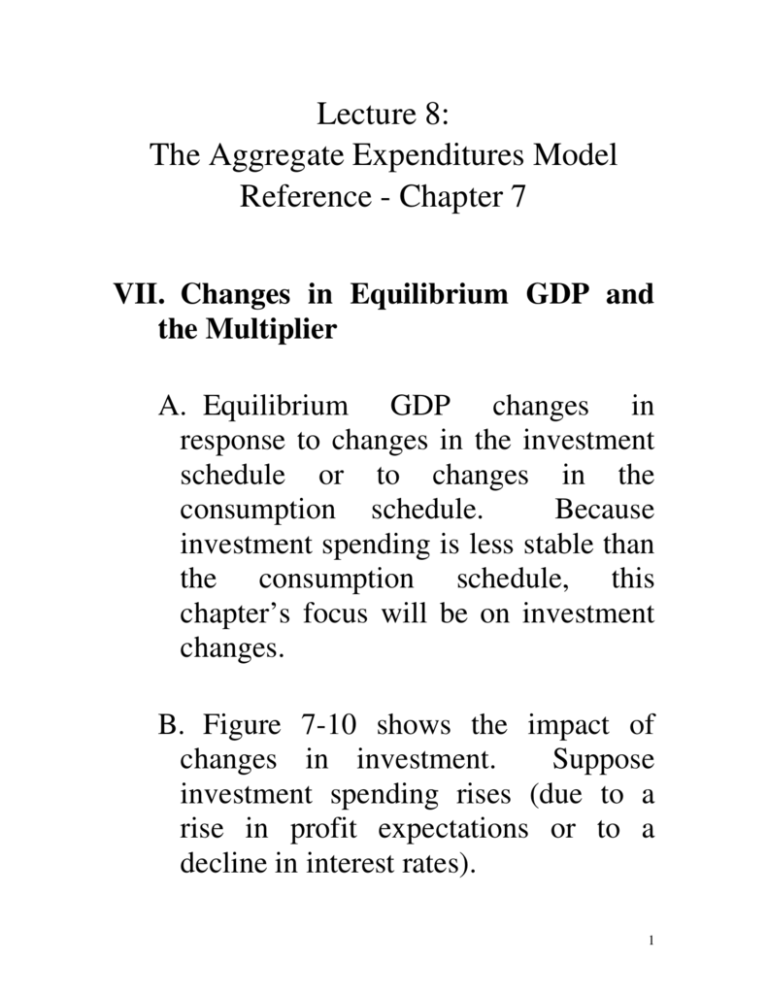
Lecture 8: The Aggregate Expenditures Model Reference - Chapter 7 VII. Changes in Equilibrium GDP and the Multiplier A. Equilibrium GDP changes in response to changes in the investment schedule or to changes in the consumption schedule. Because investment spending is less stable than the consumption schedule, this chapter’s focus will be on investment changes. B. Figure 7-10 shows the impact of changes in investment. Suppose investment spending rises (due to a rise in profit expectations or to a decline in interest rates). 1 1. Figure 7-10 shows the increase in aggregate expenditures from (C+ Ig)0 to (C + Ig)1. In this case, the $5 billion increase in investment leads to a $20 billion increase in equilibrium GDP. 2. Conversely, a decline in investment spending of $5 billion is shown to create a decrease in equilibrium GDP of $20 billion to $450 billion. C. The multiplier effect: 1. A $5 billion change in investment led to a $20 billion change in GDP. This result is known as the multiplier effect. 2. Multiplier = change in real GDP / initial change in spending. In our example M = 4. 2 3. Three points to remember about the multiplier: a. The initial change in spending is usually associated with investment because it is so volatile. b. The initial change refers to an upshift or downshift in the aggregate expenditures schedule due to a change in one of its components, like investment. c. The multiplier works in both directions (up or down). D. The multiplier is based on two facts. 1. The economy has continuous flows of expenditures and income—a ripple effect—in which dollars spent by Smith are received as income by Chin and then spent by Chin and received as income by Dubios, and so on. 3 2. Any change in income will cause both consumption and saving to vary in the same direction as the initial change in income, and by a fraction of that change. a. The rationale underlying the multiplier effect is illustrated in Table 7-5 and Figure 7-11 which is derived from the Table. E. The size of the MPC and the multiplier are directly related; the size of the MPS and the multiplier are inversely related. See Figure 711 for an illustration of this point. In equation form M = 1 / MPS or 1 / (1-MPC). a. A large MPC (small MPS) means the succeeding rounds of consumption spending shown in Figure 7-3 diminish slowly and thereby cumulate to a large change in income. 4 b. A small MPC (a large MPS) causes the increases in consumption to decline quickly, so the cumulative change in income is small. E. The significance of the multiplier is that a small change in investment plans or consumption-saving plans can trigger a much larger change in the equilibrium level of GDP. F. The multiplier given above can be generalized to include other “leakages” from the spending flow besides savings. For example, the realistic multiplier is derived by including taxes and imports as well as savings in the equation. In other words, the denominator is the fraction of a change in income not spent on domestic output. 5 VIII. International Trade and Equilibrium Output A. Net exports (exports minus imports) affect aggregate expenditures in an open economy. Exports expand and imports contract aggregate spending on domestic output. Xn can be positive or negative 1. Exports (X) create domestic production, income, and employment due to foreign spending on Canadian produced goods and services. 2. Imports (M) reduce the sum of consumption and investment expenditures by the amount expended on imported goods, so this figure must be subtracted so as not to overstate aggregate expenditures on Canadian produced goods and services. 6 2. For a closed private economy: AE = C + I g For an open private economy: AE = C + I g + X n where, X n = ( X − M ) B. The Determinants of M, X and 1. Home country (Canada) exports do not depend on home country GDP, but it depends on the GDP in foreign countries (U.S.). 2. Home country (Canada) imports depend positively on home country GDP. 3. X and M also depend on the exchange rate, the rate at which the Canadian dollar can be exchanged for other currencies. 7 4. A depreciation of Canadian dollar occurs when our currency buys fewer units of another currency or currencies. Example: 1 CDN $ = 0.8 U.S. $ to 1 CDN $ = 0.75 U.S. $ 5. An appreciation of Canadian dollar occurs when our currency buys more units of another currency or currencies. Example: 1 CDN $ = 0.8 U.S. $ to 1 CDN $ = 0.85 U.S. $ 6. Generally, an appreciation of the Canadian dollar leads to rise in M and decrease in X, thus a decrease in Xn and AE. 7. A depreciation leads to increase in Xn and AE. 8 C. The net export schedule (Table 7-6): 1. Shows hypothetical amount of net exports (X - M) that will occur at each level of GDP given in Tables 71 and 7-4. 2. The change in imports divided by the change in GDP is called the marginal propensity to import (MPM). Example: MPM=5/20=0.25. 3. MPM is the slope of the net export schedule. Example: M = 0.25Y; X = 40; Xn = X-M =40-0.25Y 4. Open economy Multiplier 1 MPS + MPM 1 1 = = =2 .25 + .25 .5 = 9 C. The impact of net exports on equilibrium GDP is illustrated in Figure 7-13 and Table 7-7. 1. Open private economy equilibrium condition: Y = C + Ig + Xn 1.Positive net exports increase aggregate expenditures beyond what they would be in a closed economy and thus have an expansionary effect. The multiplier effect also is at work. 2. Negative net exports decrease aggregate expenditures beyond what they would be in a closed economy and thus have a contractionary effect. 10 D. Global Perspective 7-3 shows 2001 net exports for various nations. E. International Linkages: 1. Prosperity abroad transfers some of their prosperity to Canadians. 2. Retaliation of tariffs can prolong the recessionary phase of business cycles. Example: The Great Depression 3. If the economy is operating below its full employment level, depreciation of the Canadian dollar and the resulting rise in net exports will increase aggregate expenditures and thus expand real GDP. 4. But if the economy already has full employment, the increase in net exports and aggregate expenditures will cause inflationary pressure. 11



